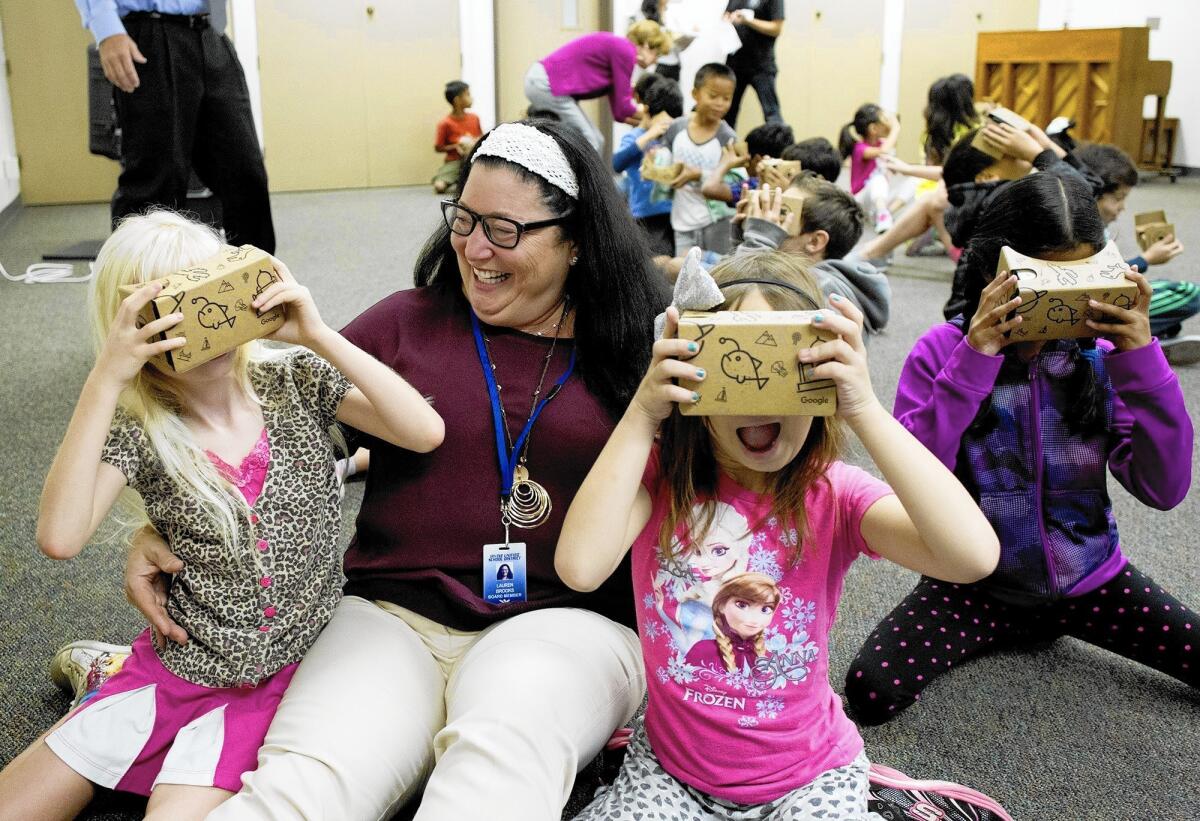Irvine students explore the world with a cardboard box, Google and a phone

The students of Santiago Hills Elementary School in Irvine traveled to the ancient ruins, underwater ecosystems and exotic forests from various corners of the world — all in just 30 minutes.
This week, the Irvine Unified School District had 12 of its campuses participate in Google’s pioneer program, Google Expeditions.
Expeditions is designed to take students on virtual field trips while staying in their classrooms.
What’s taking these students on an expedition? Just a cardboard box and a phone inside.
By looking into the cardboard box, which is shaped to fit the user’s face, a student can see the sights projected by the phone.
While similar to the toy slideshow projectors of the past century, the boxes have one extra modern-day feature — a 360-degree panoramic sphere view of each location.
Santiago Hills had students from second through sixth grade take turns using the program Tuesday. The pupils either filed into the school’s library, computer lab or multipurpose room for their turn, and each got 30 minutes to tour the globe.
Paula Venable’s fourth-grade class was the first to explore the program in the school’s computer lab.
During their session, district Educational Technology Director Kris Linville operated a tablet to choose the locations the phones would show.
The students placed the boxes over their eyes. They saw nothing but a black screen with the words “Wait for teacher” across it.
Linville scrolled through the sight choices on the tablet and tapped on a photo of Mt. Rushmore near Keystone, S.D. “Whoa!” the class erupted as they clutched their boxes tighter.
“It’s that mountain with the faces on it!” one of Venable’s students said.
As the class sat in their seats, they turned their heads from left to right and up then down, getting the full view of the American landmark.
The fourth-graders hiked through the Gobi Desert stretched across northern China and Mongolia and swam in the Great Barrier Reef off the coast of Queensland, Australia.
“We’ve been studying ecosystems, so for them to see what a coral reef looks like, not on a flat piece of paper, but in virtual space changes their experience,” Venable said. “They felt like they were under water. They became a part of what they were learning.”
On the tablet, the images are sorted into categories such as ancient ruins, museums and even careers where students can take a look into the workplace of certain professions, like a pilot or a news reporter.
The sights in Google Expeditions are licensed from numerous photographers, according to one of the program’s Expedition Leaders Zack Ketz. Multiple still images of the locations are shot and stitched together to create the 360-degree view.
In addition to Santiago Hills, Ketz said he has visited around 30 school sites this month to pilot the program. Expeditions teams plan to visit more campuses in the United States, Australia, Brazil, New Zealand and the United Kingdom this school year.
Each school needs a minimum of six interested teachers before signing up online to use the program. Teams will visit the sites that show the “most interest first” at no cost to the schools.
Across from Santiago Hills’ computer lab Tuesday, a class of second-graders in the multipurpose room had their faces and hands glued to the boxes as they stepped through an underwater location. When looking down, the students could see the algae that grew on the reefs. When looking up, they saw the light of the sun break through the ripples of the water.
“The point is to give them visual and immersible content,” Ketz said. “If they’re learning a certain concept or idea in the classroom, this is meant to supplement that lesson plan.”
According to Ketz, the pilot period is meant to draw feedback on the devices so that Google may refine the technology and concept before marketing the product.
